East Kirkton Quarry
East Kirkton Quarry, or simply East Kirkton, is a former limestone quarry in West Lothian, Scotland, now a renowned fossil site. The quarry is known for terrestrial and freshwater fossils about 335 million years old, from the late Viséan stage of the Mississippian subperiod (Early Carboniferous Period).[1][2][3] The quarry is a 200 meter-long (~650 ft) depression located in the town of Bathgate. Geographically, it sits at the Bathgate Hills near the center of the Midland Valley, a fossil-rich region of southeast Scotland.[4] The site is dominated by volcanic tuff, limestone, and silica deposits of large freshwater lakes associated with hot springs and local basaltic (high-iron) volcanism. Three geological intervals are exposed: the East Kirkton Limestone (oldest), Little Cliff Shale (middle), and Geikie Tuff (youngest).
East Kirkton Quarry | |
|---|---|
Geologic site | |
 An overgrown limestone outcrop at East Kirkton, 2013 | |
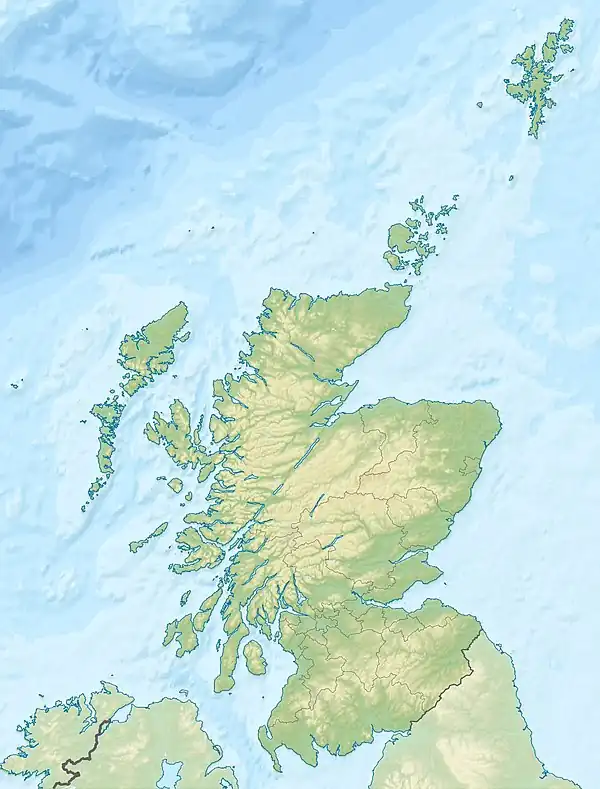 East Kirkton Quarry 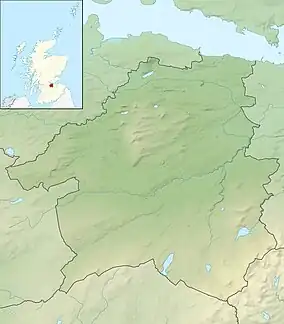 East Kirkton Quarry | |
| Coordinates: 55.903975°N 3.616536°W | |
| Location | Bathgate, West Lothian, Scotland, United Kingdom |
| Age | Viséan, Carboniferous |
The East Kirkton Limestone in particular has produced numerous well-preserved fossils of tetrapods (four-limbed vertebrates) and arthropods (multi-legged chitinous invertebrates like millipedes and arachnids). East Kirkton had been ignored by paleontologists since the 1840s, but Scottish fossil collector Stan Wood managed to procure the land in 1985, sparking a rush of scientific interest. New species from East Kirkton have been named on a regular basis since 1990, and nearly all of these species have been found nowhere else. Notable discoveries include Westlothiana (one of the most reptile-like Mississippian tetrapods), Balanerpeton (a common early representative of amphibians in the group Temnospondyli), and Pulmonoscorpius (the largest known terrestrial scorpion). The East Kirkton area represents an unconventional environment: dry woodlands and mineral-rich lakes nestled among volcanic cinder cones. Aquatic animals, though not uncommon, are less diverse than those found in the swampy coal forests and coastal sediments prevalent at other Scottish Carboniferous fossil sites. The prevalence of terrestrial organisms represents a broader trend of decreasing reliance on an amphibious lifestyle during the Carboniferous Period.
History
Early history (1825 – 1983)
As early as the 1820s, East Kirkton was noted to be an enigmatic site, relevant to broad debates on the nature of geological processes.[5] In the late 18th and early 19th centuries, petrologists (geologists who study the formation of rocks) were split into two camps. Neptunists argued that most rocks precipitated out of mineral-rich waters, while plutonists identified magma as the medium from which most rocks originate. Experiments on carbonate-based rocks (such as limestone) supported neptunist interpretations of petrology, while evidence from silica-based rocks (such as granite) favored plutonist views.[6] East Kirkton presented a contradiction: thick layers of carbonate (limestone) intermingled alongside rarer siliceous (chert) beds, emphasizing how both rock types can occur in close succession.[5][7]
The first geologist to study the site was John Fleming (1825), a Scottish neptunist who considered both the carbonate and chert to be derived from heated groundwater.[5] During the 1830s and 1840s, the quarry yielded some interesting fossils of Carboniferous plants and eurypterids ("sea scorpions", a type of extinct arthropod), though this was not uncommon for quarries in the area.[5][8][9][10] English geologist Samuel Hibbert (1836) discussed Fleming's interpretation, identifying the limestone as freshwater due to the prevalence of plant fossils and the absence of marine fossils. He drew attention to the occurrence of volcanic tuff at the site, and attributed the silica and carbonate to hot spring mineralization.[8]
When the quarry ceased operations in 1844, the site was, for the most part, forgotten as a geological footnote.[10] Scottish geologist Archibald Geikie (1861) determined that the limestone of "Kirkton" was not a single unit, but instead two distinct sequences, one at the nearby West Kirkton quarry and the other at East Kirkton. He supported Hibbert's interpretation, considering the Kirkton quarries to represent large lakes influenced by hot springs on an ancient volcanic plain.[7] East Kirkton saw little attention in the following decades, as neptunism diminished in most applications while plutonism established itself as a robust scientific theory. The land south of the quarry was developed for housing while the quarry sat abandoned.[11][12] The prevailing view was that, with the exception of rare freshwater eurypterids, East Kirkton's fossil content was comparatively unremarkable.[1][10][13] One notable study in the century since Geikie's paper was by Muir and Walton (1957), who reviewed previous research and investigated the carbonate's microscopic texture and origin in more detail.[9]
Stan Wood's fossil discoveries (1984 – present)

East Kirkton's decades of obscurity ended in 1984, when Scottish fossil collector Stan Wood discovered a fragmentary tetrapod skull among the limestone slabs of the quarry's spoil heap.[11] According to popular accounts, he became aware of the spoil heap while refereeing a football match in a nearby field. Wood purchased the abandoned quarry from the West Lothian District Council the following summer.[14] Wood and University of Cambridge paleontologist Timothy R. Smithson began systematic fossil collection from the quarry from 1985–1990. With news of the discovery, a team of National Museums of Scotland geologists (headed by W.D. Ian Rolfe) initiated a stratigraphic investigation in 1987–1992.[15][1][10]
Fossils discovered by Wood include an expansive sample of both terrestrial and freshwater fossil arthropods and early amphibians from the East Kirkton Limestone.[16] A smaller sample of fish and plant fossils were found in younger strata a few years later.[10] Wood and his colleagues published on their initial finds in a 1985 Nature letter.[16][10][13] Two notable taxa mentioned in the 1985 letter were the oldest known harvestman (a "daddy longleg", dubbed Brigantibunum in 2005)[17] and the oldest known temnospondyl amphibian (described as Balanerpeton in 1993).[18] East Kirkton is perhaps most famous for Westlothiana, a small tetrapod discovered in 1988 and initially reported to be the oldest known reptile in 1989.[19][20] Wood's excavations at East Kirkton, and then-unnamed Westlothiana, were featured in the first episode of Lost Worlds, Vanished Lives, a 1989 BBC documentary hosted by Sir David Attenborough.[14] Westlothiana has subsequently been reinterpreted as a stem-amniote reptiliomorph. In other words, it was an amphibian closely related to amniotes (the group containing dry-adapted tetrapods like reptiles and mammals, with reinforced eggs and thickened skin). Thanks to its degree of completeness, Westlothiana is still among the best paradigms of the amphibian-amniote transition.[21][22]
East Kirkton was the main subject of a conference hosted by the Royal Society of Edinburgh in 1992. The conference produced a series of over 20 papers published in 1993–94 as "Volcanism and early terrestrial biotas" (volume 84, issues 3–4 of Earth and Environmental Science Transactions of The Royal Society of Edinburgh).[1][10][23][13] New species have continued to be described from Wood's collections and other expeditions up to the present day.[13][24][25] In 2011, Cambridge paleontologist Jennifer A. Clack named a new species of East Kirkton microsaur, Kirktonecta milnerae, in honour of the site.[26] East Kirkton Quarry has been designated as both a Local Geodiversity Site (LGS) of West Lothian and a Site of Special Scientific Interest (SSSI).[27]
Geology

The East Kirkton Quarry preserves up to 19 m (62 ft) of strata from the mid-lower part of the Bathgate Hills Volcanic Formation. It is equivalent in time to rocks from the upper part (Hopetoun Member) of the West Lothian Oil-Shale Formation, exposed north of Linlithgow.[28] Both formations are part of the broader Strathclyde Group[29] (informally termed the Oil-Shale Group)[10] found throughout the Midland Valley of Scotland.[30][29][31]
By comparison to equivalent oil shale strata, the East Kirkton is estimated to belong to the Brigantian (uppermost Viséan global stage) of the Mississippian Subperiod (the lower part of the Carboniferous Period). This would place it near the end of the regional Dinantian stage.[10] In numerical terms, the site may be 330[32] to 338[33] million years old, with 335 million years as a common estimate.[10][23]
East Kirkton is one of many geographically restricted limestone deposits cropping out on a north-south tangent between Bathgate and Linlithgow.[8][28] The nearby West Kirkton Quarry is a slightly younger marine limestone deposit.[7][28] West Kirkton failed to produce any significant fossils, as it had been filled in and redeveloped by the time Stan Wood began his excavations in 1985.[14]
The rocks of East Kirkton dip (decline) into the west wall of the quarry. Magnetometer and resistivity surveys reveal a small north-south fault just west of the quarry. Vertical displacement of strata along the fault would have been responsible for bringing fine-grained sediments to the surface. The fault indicates that the localized nature of the site is a consequence of modern tectonic processes rather than ancient restricted deposition.[12]
Three distinctive geological intervals can be found at the quarry: the Geikie Tuff (youngest / highest), Little Cliff Shale (middle), and East Kirkton Limestone (oldest / lowest). The most well-exposed area is a 15 m (49 ft) thick outcrop at the northwest edge of the quarry. Here, the three intervals are subdivided further into a series of thin units, labelled 1 to 88 from the top of the outcrop (the youngest point) to the bottom of the outcrop (the oldest point).[10]
Geikie Tuff
The Geikie Tuff (units 1–31), as the name implies, consists mainly of yellowish-green volcaniclastic tuff. Fossils, though abundant in a few layers, are limited in diversity and preservation. They mainly include fish scales, plant fragments, and shells of ostracods (tiny bivalved crustaceans). Ironstone nodules are also present. The Geikie Tuff is more than 4 m (13 ft) thick at the main outcrop, though it can reach 8 m (26 ft) thick in exploratory boreholes.[10] Stratigraphic sections acquired via boreholes have demonstrated that the tuff is overlain by basalt.[10][12]
Pseudomorphs of olivine and plagioclase crystals indicate that the tuff is basaltic in nature. The volcanic grains are coarse and rounded, sorted into discontinuous lenticular layers with graded bedding. This suggests that the volcanic material was not directly supplied by a pyroclastic flow, base surge, or ash fall. Rather, it was washed down as debris from older ash deposits, settling underwater alongside wood and other non-volcanic fragments. The area most likely experienced small intermittent cinder cone eruptions, providing basaltic ash or lava as a predecessor to the tuff material.[15][34]
Little Cliff Shale
The Little Cliff Shale (units 21–36) is the thinnest interval exposed at the site. It reaches its greatest thickness (about 1.85 m or 6.07 ft) near the middle of the quarry's west wall. The sediments of the Little Cliff Shale include blue-gray shale interspersed with greenish tuff. Fossils and ironstone are more common than in the Geikie Tuff, with the addition of scorpion cuticle and a greater diversity of plant and fish remains.[15][10]
East Kirkton Limestone

The East Kirkton Limestone (units 36–88) is by far the thickest, most fossiliferous, and most geologically diverse sequence in the quarry.[10] Most layers are laminated (thinly layered) limestone, with a fine-grained texture of calcareous spherulites (bead-like grains). Black shale, coarse tuffaceous limestone, silica (chert and chalcedony), pyrite, gypsum, and tuff beds may occur in some layers.[9][15][10] Tetrapod, arthropod, and plant fossils are abundant throughout the limestone. Conversely, fish are absent beyond unit 36 and ostracods are mostly restricted to black shale-bearing horizons. Many laminated beds are deformed or warped, and stromatolitic crusts and algal filaments are common.[10] Small slumping features can be seen in some layers, likely corresponding to the slope between shallow and deep parts of a lake bed.[9][35] The lake bed was probably oxygen-deprived, according to trace metal geochemical markers and an absence of bioturbation (animal-mediated disturbance).[15][36] The true thickness of the limestone is unknown, but about 9 m (30 ft) are exposed on the main outcrop.[10]
Stable isotope data help to pin down the origin of minerals like silica and pyrite in the limestone. Hydrogen and oxygen isotope ratios indicate that the chert beds precipitated from meteoric water heated to around 60°C (140°F), with a minor amount of mineral recycling after deposition. Sulfur molecules in pyrite are rather lightweight, arguing that crystal formation was mediated by bacterial activity. Yet the pyrite was also heavy enough to imply a constant supply of sulfur-34, likely from older gypsum beds heated by magmatic activity.[37] Both the silica and pyrite support historical interpretations of a hydrothermal influence on the East Kirkton Limestone.[15][37] Another hypothesis, based on strontium isotope trends, is that heat and alkaline groundwater are byproducts of chemical reactions between tuff minerals and carbon dioxide molecules seeping in via meteoric water (such as rain).[38]
Contrary to earlier suggestions,[5][8][7][15] the calcareous minerals of East Kirkton Limestone (mostly calcite) are probably not directly hydrothermal in origin.[9][36][35] Nevertheless, East Kirkton is a useful model for the formation of spherulite-rich freshwater limestone in volcanic settings.[9][35] Most limestones with spherulites are dependent on a high proportion of clay particles, but clay makes up only a small portion of the East Kirkton Limestone. The prevailing interpretation is that spherulite formation at East Kirkton follows a complex mineralization pathway.[9][36][35]
In the reconstructed sequence of spherulite formation, freshwater lakes are supplied with high concentrations of dissolved alkaline minerals and microbial acids. These conditions encourage the precipitation of fibrous calcite, which accumulates on strands of organic material such as algae or cyanobacteria In the shallow part of a lake. The fibrous calcite acts as a base for radiating balls of botryoidal (lumpy) calcite. Even once the algae die and settle, the calcite continues stacking up into crusts and domes on the lake bed. Fluctuating mineral concentrations lead to constant corrosion and reprecipitation of the calcite. Wave action breaks up the calcite crusts into smaller grains, which are periodically washed into deeper parts of the lake. This periodic supply of spherulite grains is responsible for the laminated appearance of the limestone, alternating between microscopic bands of dark clay and organic material, and thicker (though still narrow) bands of calcite.[36][35] Diagenesis (underground heat and pressure) fractures and warms the calcite after deposition, introducing voids and further reprecipitation within the molds of algal strands.[9][35]
Palaeoenvironment
.jpg.webp)
During the Dinantian, the Midland Valley would have been a subtropical lowland rift zone. Faults and cooled lava flows would have contributed to the landscape by diverting rivers and damming lakes,[39] as would the progradation of deltaic systems further east.[40] Some of the lakes may have filled in volcanic craters, forming low crater lakes (also known as maars). Most individual volcanoes were small but numerous, emphasizing basaltic and phreatic eruptions alongside hot springs. Modern equivalent environments include the system of volcanoes around the Mozambique Channel and the Chaîne des Puys in France.[39]
Towards the north and east was a large lake or estuary system known to geologists as Lake Cadell. It was responsible for the deposition of most sediments comprising the West Lothian Oil-Shale Formation. An expanse of dry volcanic uplands were located west of East Kirkton. These uplands, formally known as the Clyde Plateau, completely lacked any form of limestone deposition. The East Kirkton Limestone was deposited at a time and place at the intersection between these two environments, as the expanding dry plateau began to displace the brackish lake, enabling the development of a riparian ecosystem in the Bathgate area.[29][35]
East Kirkton was located close to the equator in the Viséan. The climate was warm and semi-arid, gradually becoming wetter as the Carboniferous progressed.[41][39][28][42] Rainfall was prevalent enough to support woodlands and lake ecosystems, but infrequent enough to dissuade coal forests and allow gypsum deposition.[39][28][42] The more humid conditions of the Geikie Tuff may correspond to the expansion of a larger lake into the East Kirkton area.[28] Chert and pyrite, alongside permineralized plant fossils, may indicate that hot springs were prevalent during the deposition of the East Kirkton Limestone.[28][43]
Paleobiota and paleoecology
Color key
|
Notes Uncertain or tentative taxa are in small text; |
Tetrapods
East Kirkton tetrapod fossils have all been preserved in aquatic sediments of the East Kirkton Limestone. A majority of the fossils come from laminated spherulitic limestone slabs (units 70 and below), though the best-preserved specimens come from a thin black shale layer (unit 82). Fish fossils do not occur alongside tetrapod fossils, suggesting that the tetrapods lived in or around shallower bodies of water than those supporting the local freshwater fish.[44]
The tetrapod species of East Kirkton are all endemic, though some broader groups (dendrerpetontids, aistopods, "anthracosaurs", etc.) can be found at other Carboniferous locales. Notably absent are adelogyrinids, Crassigyrinus, Doragnathus, and lysorophians, all of which are considered fully aquatic.[15][44] The absence of lysorophians could be explained by the age of East Kirkton, which is much older than the known aquatic members of the group.[44] True amniotes are also absent, and only a single microsaur fossil has been discovered.[26] The rarity of microsaurs may be due to geographic rather than environmental factors, since few fossils of the group are known from other British sites. Overall, East Kirkton has a more terrestrial character than other Scottish fossil sites, though a few aquatic or semi-aquatic species certainly inhabited the area as well.[44]
| Tetrapods of East Kirkton | |||||
|---|---|---|---|---|---|
| Genus / Taxon | Species | Strata | Material | Notes | Images |
| Balanerpeton[18] | B. woodi | East Kirkton Limestone | Over 30 specimens, including skulls and nearly complete skeletons[18] | A medium-sized terrestrial temnospondyl similar to Dendrerpeton.[18] | 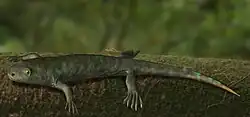 |
| Eldeceeon[45] | E. rolfei | East Kirkton Limestone | Four partial skeletons, two of which are nearly complete[46] | A medium-sized "anthracosaur" with proportionally large hindlimbs and proposed terrestrial habits.[45][46] Initially identified as an unnamed "Eoherpeton"-like form.[15] | 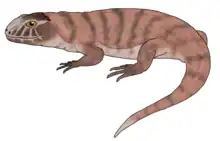 |
| Embolomeri | Indeterminate | East Kirkton Limestone | Skull fragments (pterygoid, quadratojugal, lower jaw)[24] | A large indeterminate embolomere with an estimated skull length of 20 cm (7.8 inches), the largest reported for a Mississippian embolomere.[24] | |
| Eucritta[47] | E. melanolimnetes | East Kirkton Limestone | Four partial skeletons and an isolated skull roof[48] | A small baphetoid with a mosaic of features from other tetrapod groups.[47][48] Initially identified as an unnamed loxommatid.[15] | 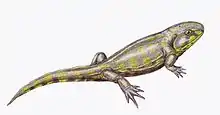 |
| Kirktonecta[26] | K. milnerae | East Kirkton Limestone | Single nearly complete skeleton[26] | A very small newt-like aquatic microsaur, with soft tissue of a deep tail fin.[26] | |
| Ophiderpeton | O. kirktonense[49] | East Kirkton Limestone | Five partial skeletons, including skull material[49] | A small aistopod, a type of snake-like legless tetrapod.[49] | 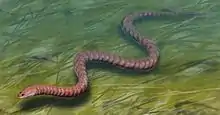 |
| Silvanerpeton[50] | S. miripedes | East Kirkton Limestone | Nine partial skeletons, including skull material[51] | A small "anthracosaur" with short limbs.[51] | 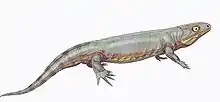 |
| Westlothiana[20] | W. lizziae | East Kirkton Limestone | Two nearly complete skeletons[21] | A small, slender reptiliomorph.[21] When the holotype specimen, "Lizzie", was discovered in 1988, it was reported to be the oldest known reptile[19][20] (or, more precisely, the oldest known amniote). Subsequent studies have reinterpreted it as a stem-amniote tetrapod close to the ancestry of amniotes[21] and/or lepospondyls.[22] | |
| Temnospondyli | Indeterminate | East Kirkton Limestone | Isolated ribs[18] | A large (~2 meter, 6.6 feet) indeterminate temnospondyl, possibly related to Edops.[18][23] | |
| Termonerpeton[25] | T. makrydactylus | East Kirkton Limestone | Single partially articulated posterior torso[25] | A large "anthracosaur"-like tetrapod with a foot similar to Eldeceeon and amniotes.[25] | |
Fish
Though few of East Kirkton's fish species have been formally described, available information suggests that the East Kirkton lake hosted a diverse freshwater ecosystem. Body types seen in East Kirkton fish include fusiform (tuna-shaped) generalist predators and deep-bodied durophages (Eurynotus). The fish fauna is comparable to other sites in the Mississippian Oil Shales of Scotland. Only the Granton shrimp bed, a fully marine environment, lacks freshwater fish and tetrapods.[52]
Beside direct body fossils of fish, coprolites are also found in several layers near the Little Cliff Shale-East Kirkton Limestone transition. Small pellet- bullet- and cigar-shaped coprolites are common, often containing ostracod shells, and in one case, bone fragments. One irregular mass, containing ostracods and plant fragments, may be a regurgitate. Elongated spiralling coprolites are rarer and would have been produced by elasmobranchs akin to modern sharks. Irregular or strand-like coprolites may have been produced by tetrapods, though fish cannot be excluded. Massive clusters of phosphatized grains were probably produced by large omnivorous eurypterids like Hibbertopterus, or less likely large rhizodont fish.[53]
Bony fish
| Bony fish (Osteichthyes) of East Kirkton | |||||
|---|---|---|---|---|---|
| Genus / Taxon | Species | Strata | Material | Notes | Images |
| Actinopterygii | Unnamed | East Kirkton Limestone,
Little Cliff Shale, Geikie Tuff |
Numerous isolated scales, four partial skeletons (two of which may be juveniles), and an isolated maxilla[52] | At least five different unnamed species of actinopterygians (ray-finned fish), labelled A to E. Comparable to "Rhadinichthys" (species A and B), Elonichthys (juveniles), Mansfieldiscus (species C), Mesopoma (species D), and Cosmoptychius (species E).[52][23] | |
| Eurynotus | E. sp. | East Kirkton Limestone,
Little Cliff Shale |
Five specimens, including a semi-complete skeleton[52] | A platysomid actinopterygian with a fairly deep body and durophagous diet. Up to 9.6 cm (3.8 inches) long, not counting the head or tail-fin.[52] | |
| Rhizodontida | Indeterminate | Little Cliff Shale | A patch of scales[23] | A large predatory rhizodont, possibly up to 5 m (16.4 feet) in length.[23] | |
Cartilaginous fish
| Cartilaginous fish (Chondrichthyes and Acanthodii) of East Kirkton | |||||
|---|---|---|---|---|---|
| Genus / Taxon | Species | Strata | Material | Notes | Images |
| Acanthodidae? | Indeterminate | Little Cliff Shale,
Geikie Tuff |
Three specimens: a disarticulated skeleton and fragments of a fin spine and pectoral girdle[52] | A tiny acanthodiform similar to Acanthodes,[23] Acanthodopsis, or Howittacanthus.[52] | |
| Climatiidae? | Indeterminate | Geikie Tuff | Single bony plate[52] | A possible late-surviving climatiid similar to Climatius.[52] | |
| Diplodoselache | D. woodi? | East Kirkton Limestone,
Little Cliff Shale |
Three teeth[54] | A xenacanth "shark" (elasmobranch).[54] | |
| Tristychius | T. arcuatus? | East Kirkton Limestone,
Little Cliff Shale |
Fin spines (two complete and six fragmentary) up to 4 cm (1.6 inches) in length[54] | A hybodont "shark" (elasmobranch).[54] |  |
Invertebrates
Apart from arthropods, other identified invertebrates include freshwater ostracods (Carbonita) and bivalves (Curvirimula?).[10] Ostracods likely formed the base of the aquatic food chain, since they have been found as stomach contents in several fish and tetrapod fossils.[23]
| Arthropods of East Kirkton | |||||
|---|---|---|---|---|---|
| Genus / Taxon | Species | Strata | Material | Notes | Images |
| Brigantibunum[17] | B. listoni | East Kirkton Limestone | Single compressed partial specimen[23] | A small harvestman (Opiliones) with very long thin legs, possibly a member of the suborder Eupnoi.[17] | |
| Hibbertopterus | H. scouleri | East Kirkton Limestone | Partially articulated specimens and isolated fragments[55] | A massive semi-terrestrial hibbertopterid eurypterid, with a carapace up to 65 cm (26 inches) in diameter. Some specimens were previously placed in the genera Cyrtoctenus and Dunsopterus.[55][23] |  |
| Myriapoda | Unnamed | East Kirkton Limestone | Multiple specimens, six of which are complete enough to describe[56] | At least three species of many-legged arthropods, including a possible glomeridesmid (slug millipede), another millipede with ozopores (scent glands), and a putative non-millipede myriapod.[23][56] | |
| Pulmonoscorpius[57] | P. kirktonensis | East Kirkton Limestone,
Little Cliff Shale |
16 complete specimens and hundreds of cuticle fragments[57] | A large basal scorpion up to 70 cm (28 inches) in length, the largest terrestrial scorpion known. Two distinctive specimens may represent additional species of Pulmonoscorpius.[57] Initially reported as Gigantoscorpio.[15] |  |
| Scorpionida | Indeterminate | East Kirkton Limestone,
Little Cliff Shale |
Cuticle fragments[57] | At least two species of indeterminate scorpions, including an aquatic "archaeoctonoid" and a terrestrial "orthostern". One piece of scorpion cuticle apparently sheltered a mite.[57] | |
Plants
The plant fossils of East Kirkton are fragmentary but diverse, and small fragments of fusain (fossilized charcoal) are common in the East Kirkton Limestone.[15][42] The area was likely forest or open woodland frequented by wildfires. There are few aquatic plants apart from algal laminations, and lycopsid fragments (an indicator of swamp forests) are only common in the Geikie Tuff. The surrounding woods were probably drier during the deposition of the Little Cliff Shale and East Kirkton Limestone. The East Kirkton flora is fairly typical among Viséan Scotland, most species found here have been reported previously from the Midland Valley.[42]
Gymnosperm wood and fern leaves (particularly Spathulopteris and Sphenopteridium) are the most common plant fossils at East Kirkton. These plants are also abundant at Weaklaw, a Viséan-age volcanic ash deposit in East Lothian. It is uncertain whether this similarity betrays a preference for volcanic areas or simply broader biostratigraphy.[42]
Plant fossils have been fossilized through several different chemical pathways. In the East Kirkton Limestone, robust plant parts such as gymnosperm branches and Stigmaria roots are often preserved by permineralization (petrification). During permineralization, the original organic material is sequentially replaced with silica and/or carbonate carried by alkaline groundwater. More commonly, heat and pressure compresses organic matter into carbonaceous films. These coalified compressions of wood and foliage can be found in practically every layer of the site. Some fossils are both compressed and permineralized, particularly in the upper layers (units 44–48) of the East Kirkton Limestone.[15][43]
Gymnosperms
| Gymnosperms of East Kirkton | |||
|---|---|---|---|
| Genus / Taxon | Species | Strata | Notes |
|
Bilignea |
B. solida |
East Kirkton Limestone |
Woody gymnosperm stems or branches up to 3.5 cm (1.4 inches) in diameter.[42][58] |
|
Eristophyton |
E. fasciculare |
East Kirkton Limestone |
Common woody gymnosperm branches up to 6 cm (2.4 inches) in diameter.[42][58] |
| Lyginorachis |
L. kingswoodense |
East Kirkton Limestone | Gymnosperm stems.[42] |
|
L. spp. | |||
|
Pitus |
P. withamii |
East Kirkton Limestone |
Woody arborescent (tree-sized) gymnosperm trunks up to 50 cm (20 inches) in diameter.[42][58] |
|
cf. Protopitys |
cf. scotica |
An isolated progymnosperm branch.[42] | |
|
Stanwoodia[59] |
S. kirktonensis |
East Kirkton Limestone |
Woody gymnosperm stems or branches up to 3 cm (1.2 inches) in diameter.[59][42][58] |
Lycopsids
| Lycopsids of East Kirkton | |||
|---|---|---|---|
| Genus / Taxon | Species | Strata | Notes |
|
Lepidocarpon |
L. wildianum |
Fragmentary lycopsid cones.[42] | |
|
L. sp. |
Little Cliff Shale, Geikie Tuff |
||
|
Lepidophloios |
L. sp. |
East Kirkton Limestone |
|
|
Lepidophylloides |
L. sp. |
Fragmentary lycopsid leaves.[42] | |
|
L. sp. |
Little Cliff Shale |
Fragmentary lycopsid cones.[42] | |
|
East Kirkton Limestone, Little Cliff Shale |
Lycopsid leaves and sporophylls referable to Lepidophyllum, Cyperites and Lepidostrobophyllum.[42] | ||
|
S. sp. |
East Kirkton Limestone, Geikie Tuff |
||
Ferns
| Ferns of East Kirkton | |||
|---|---|---|---|
| Genus / Taxon | Species | Strata | Notes |
| Adiantites | A. antiquus | East Kirkton Limestone | Fern frond fragments.[42] |
| A. macahenkii | |||
|
Archaeopteridium |
A. cf. tschermakii |
East Kirkton Limestone |
Fern frond fragments.[42] |
|
Botryopteris |
B. cf. antiqua |
Small fern stem fragments.[42] | |
|
Diplothmema |
D. sp. |
East Kirkton Limestone |
Fern frond fragments.[42] |
| Rhodea | R. gigantea | East Kirkton Limestone | Large common fern fronds.[15][42] |
|
R. sp. | |||
| Spathulopteris | S. decomposita | East Kirkton Limestone | Common fern fronds, leaves, and pinnules.[42] |
|
S. dunsii | |||
|
S. obovata | |||
| Sphenopteridium | S. crassum | East Kirkton Limestone | Common fern fronds, leaves, and pinnules.[15][42] |
|
S. pachyrrachis | |||
| Sphenopteris | S. affinis | East Kirkton Limestone,
Little Cliff Shale |
Fern leaves and pinnules.[15][42] |
| S. clavigera | East Kirkton Limestone | ||
| S. cf. fragilis | East Kirkton Limestone | ||
Horsetails
| Horsetails of East Kirkton | |||
|---|---|---|---|
| Genus / Taxon | Species | Strata | Notes |
|
Archaeocalamites |
A. sp. |
Fragmentary sphenopsid (horsetail) stems.[42] | |
| Indeterminate |
East Kirkton Limestone |
||
See also
References
- Rolfe, W. D. Ian (1993). "Preface". Earth and Environmental Science Transactions of the Royal Society of Edinburgh. 84 (3–4): 175. doi:10.1017/S0263593300005976. ISSN 1755-6910.
- East Kirkton, Bathgate (GCR ID: 2757) in Dineley, D. and Metcalf, S. (1999) Fossil Fishes of Great Britain, Geological Conservation Review Series, No. 16, Joint Nature Conservation Committee, Peterborough, 675 pp. Chapter 15: Sites of British Fossil stem Tetrapoda and Amphibia. Retrieved 2014-04-08.
- White, T. & Kazlev, M.A. (2004): Paleozoic Sites, part 2 Archived 2010-11-26 at the Wayback Machine, from Palaeos website.
- Benton, M. (2005): Vertebrate Palaeontology 3rd edition. Blackwell Publishing
- Fleming, J (1825). "On the Neptunean Formation of Siliceous Stalactities". Edinburgh Journal of Science. II (XXIV): 307–312.
- Master, Sharad (2009). "Plutonism versus Neptunism at the southern tip of Africa: the debate on the origin of granites at the Cape, 1776–1844". Earth and Environmental Science Transactions of the Royal Society of Edinburgh. 100 (1–2): 1–13. doi:10.1017/S1755691009016193. ISSN 1755-6910.
- Geikie, A (1861). Howell, H.H.; Geikie, A. (eds.). "The Geology of the Neighbourhood of Edinburgh". Memoirs of the Geological Survey of Scotland.
- Hibbert, S (1836). "On the fresh-water limestone of Burdiehouse, in the neighbourhood of Edinburgh, belonging to the Carboniferous group of rocks". Transactions of the Royal Society of Edinburgh. 13: 169–280. doi:10.1017/S0080456800022250. S2CID 129601906.
- Muir, R.D.; Walton, E.K. (1957). "The East Kirkton Limestone". Transactions of the Geological Society of Glasgow. 22: 157–168. doi:10.1144/transglas.22.2.157. S2CID 128549104. Retrieved 21 October 2022.
- Rolfe, W. D. I.; Durant, G. P.; Baird, W. J.; Chaplin, C.; Paton, R. L.; Reekie, R. J. (1993). "The East Kirkton Limestone, Viséan, of West Lothian, Scotland: introduction and stratigraphy". Earth and Environmental Science Transactions of the Royal Society of Edinburgh. 84 (3–4): 177–188. doi:10.1017/S0263593300005988. ISSN 1755-6910. S2CID 129189498.
- Clack, J.A. (2002): Gaining ground: the origin and evolution of tetrapods. Indiana University Press, Bloomington, Indiana, USA. 369 pp
- Doody, Jonathan J.; McGill, Rona A. R.; Darby, David; Smythe, David K. (1993). "Geophysical surveys of the East Kirkton Limestone, Viséan, West Lothian, Scotland". Earth and Environmental Science Transactions of the Royal Society of Edinburgh. 84 (3–4): 197–202. doi:10.1017/S0263593300006003. ISSN 1755-6910. S2CID 54694814.
- Fraser, Nicholas C.; Smithson, Timothy R.; Clack, Jennifer A. (2017). "A Legacy in Fossils: a Tribute to Stan(ley) Wood – Preface". Earth and Environmental Science Transactions of the Royal Society of Edinburgh. 108 (1): 1–5. doi:10.1017/S1755691018000191. ISSN 1755-6910. S2CID 133898222.
- Smithson, Timothy R.; Rolfe, W. D. Ian (2017). "What made Stan Wood a great collector?". Earth and Environmental Science Transactions of the Royal Society of Edinburgh. 108 (1): 7–17. doi:10.1017/S1755691018000154. ISSN 1755-6910. S2CID 232148776.
- Rolfe, W.D.I.; Durant, G. P.; Fallick, A. E.; Hall, A. J.; Large, D. J.; Scott, A. C.; Smithson, T. R.; Walkden, G. M. (1990), "An early terrestrial biota preserved by Visean vulcanicity in Scotland", Geological Society of America Special Papers, Geological Society of America, vol. 244, pp. 13–24, doi:10.1130/spe244-p13, ISBN 978-0-8137-2244-3
- Wood, S. P.; Panchen, A. L.; Smithson, T. R. (1985). "A terrestrial fauna from the Scottish Lower Carboniferous". Nature. 314 (6009): 355–356. Bibcode:1985Natur.314..355W. doi:10.1038/314355a0. ISSN 0028-0836. S2CID 4251551.
- Dunlop, Jason A.; Anderson, Lyall I. (2005). "A Fossil Harvestman (Arachnida, Opiliones) from the Mississippian of East Kirkton, Scotland". Journal of Arachnology. 33 (2): 482–489. doi:10.1636/04-79.1. ISSN 0161-8202. S2CID 54722981.
- Milner, A. R.; Sequeira, S. E. K. (1993). "The temnospondyl amphibians from the Viséan of East Kirkton, West Lothian, Scotland". Earth and Environmental Science Transactions of the Royal Society of Edinburgh. 84 (3–4): 331–361. doi:10.1017/S0263593300006155. ISSN 1755-6910. S2CID 140698880.
- Smithson, T. R. (1989). "The earliest known reptile". Nature. 342 (6250): 676–678. Bibcode:1989Natur.342..676S. doi:10.1038/342676a0. ISSN 1476-4687. S2CID 4358046.
- Smithson, T. R.; Ian Rolfe, W. D. (1990). "Westlothiana gen. nov.: naming the earliest known reptile". Scottish Journal of Geology. 26 (2): 137–138. Bibcode:1990ScJG...26..137S. doi:10.1144/sjg26020137. ISSN 0036-9276. S2CID 128870375.
- Smithson, T. R.; Carroll, R. L.; Panchen, A. L.; Andrews, S. M. (1993). "Westlothiana lizziae from the Viséan of East Kirkton, West Lothian, Scotland, and the amniote stem". Earth and Environmental Science Transactions of the Royal Society of Edinburgh. 84 (3–4): 383–412. doi:10.1017/S0263593300006192. ISSN 1755-6910. S2CID 129807712.
- Ruta, M.; Coates, M.I.; Quicke, D.L.J. (2003). "Early tetrapod relationships revisited" (PDF). Biological Reviews. 78 (2): 251–345. doi:10.1017/S1464793102006103. PMID 12803423. S2CID 31298396.
- Clarkson, E. N. K.; Milner, A. R.; Coates, M. I. (1993). "Palaeoecology of the Viséan of East Kirkton, West Lothian, Scotland". Earth and Environmental Science Transactions of the Royal Society of Edinburgh. 84 (3–4): 417–425. doi:10.1017/S0263593300006210. ISSN 1755-6910. S2CID 129588430.
- Clack, Jennifer A.; Smithson, Timothy R. (2020). "A new large embolomere from East Kirkton". Scottish Journal of Geology. 56 (2): 153–158. Bibcode:2020ScJG...56..153C. doi:10.1144/sjg2020-008. ISSN 0036-9276. S2CID 224965934.
- Clack, Jennifer A.; Smithson, Timothy R.; Ruta, Marcello (14 April 2022). "A Mississippian (early Carboniferous) tetrapod showing early diversification of the hindlimbs". Communications Biology. 5 (1): 283. doi:10.1038/s42003-022-03199-x. ISSN 2399-3642. PMC 9010477. PMID 35422092.
- Clack, J.A. (2011). "A new microsaur from the Early Carboniferous (Visean) of East Kirkton, Scotland, showing soft tissue evidence". Special Papers in Palaeontology. 86: 45–56.
- "4. East Kirkton Quarry, near Bathgate". West Lothian Council. Retrieved 20 May 2023.
- Smith, R. A.; Stephenson, D.; Monro, S. K. (1993). "The geological setting of the southern Bathgate Hills, West Lothian, Scotland". Earth and Environmental Science Transactions of the Royal Society of Edinburgh. 84 (3–4): 189–196. doi:10.1017/S026359330000599X. ISSN 1755-6910. S2CID 128491240.
- Whyte, Martin A. (1993). "Scottish Carboniferous fresh-water limestones in their regional setting". Earth and Environmental Science Transactions of the Royal Society of Edinburgh. 84 (3–4): 239–248. doi:10.1017/S0263593300006052. ISSN 1755-6910. S2CID 130230262.
- Maddox, Steven J.; Andrews, Julian E. (1987). "Lithofacies and stratigraphy of a Dinantian non-marine dolostone from the Lower Oil-Shale Group of Fife and West Lothian". Scottish Journal of Geology. 23 (2): 129–147. Bibcode:1987ScJG...23..129M. doi:10.1144/sjg23020129. ISSN 0036-9276. S2CID 128485230.
- Andrews, Julian E.; Nabi, Ghulam (1994). "Lithostratigraphy of the Dinantian Inverclyde and Strathclyde Groups, Cockburnspath Outlier, East Lothian – North Berwickshire". Scottish Journal of Geology. 30 (2): 105–119. Bibcode:1994ScJG...30..105A. doi:10.1144/sjg30020105. ISSN 0036-9276. S2CID 129170097.
- van Tuinen, Marcel; Hadly, Elizabeth A. (2004). "Error in Estimation of Rate and Time Inferred from the Early Amniote Fossil Record and Avian Molecular Clocks". Journal of Molecular Evolution. 59 (2): 267–276. Bibcode:2004JMolE..59..267V. doi:10.1007/s00239-004-2624-9. ISSN 0022-2844. PMID 15486700. S2CID 25065918.
- Paton, R. L.; Smithson, T. R.; Clack, J. A. (1999). "An amniote-like skeleton from the Early Carboniferous of Scotland". Nature. 398 (6727): 508–513. Bibcode:1999Natur.398..508P. doi:10.1038/19071. ISSN 1476-4687. S2CID 204992355.
- Durant, Graham P. (1993). "Volcanogenic sediments of the East Kirkton Limestone (Viséan) of West Lothian, Scotland". Earth and Environmental Science Transactions of the Royal Society of Edinburgh. 84 (3–4): 203–207. doi:10.1017/S0263593300006015. ISSN 1755-6910. S2CID 130094185.
- Mercedes-Martín, Ramon; Brasier, Alexander T.; Rogerson, Mike; Reijmer, John J.G.; Vonhof, Hubert; Pedley, Martyn (2017). "A depositional model for spherulitic carbonates associated with alkaline, volcanic lakes". Marine and Petroleum Geology. 86: 168–191. Bibcode:2017MarPG..86..168M. doi:10.1016/j.marpetgeo.2017.05.032.
- Walkden, Gordon M.; Irwin, J. Roddy; Fallick, Anthony E. (1993). "Carbonate spherules and botryoids as lake floor cements in the East Kirkton Limestone of West Lothian, Scotland". Earth and Environmental Science Transactions of the Royal Society of Edinburgh. 84 (3–4): 213–221. doi:10.1017/S0263593300006039. ISSN 1755-6910. S2CID 130262398.
- McGill, R. A. R.; Hall, A. J.; Fallick, A. E.; Boyce, A. J. (1993). "The palaeoenvironment of East Kirkton, West Lothian, Scotland: stable isotope evidence from silicates and sulphides". Earth and Environmental Science Transactions of the Royal Society of Edinburgh. 84 (3–4): 223–237. doi:10.1017/S0263593300006040. ISSN 1755-6910. S2CID 130931606.
- Rogerson, Mike; Mercedes-Martín, Ramon; Brasier, Alexander T.; McGill, Rona A.R.; Prior, Timothy J.; Vonhof, Hubert; Fellows, Simon M.; Reijmer, John J.G.; McClymont, Erin; Billing, Ian; Matthews, Anna; Pedley, H. Martyn (2017). "Are spherulitic lacustrine carbonates an expression of large-scale mineral carbonation? A case study from the East Kirkton Limestone, Scotland". Gondwana Research. 48: 101–109. Bibcode:2017GondR..48..101R. doi:10.1016/j.gr.2017.04.007.
- Upton, B. G. J. (1993). "Regional setting of Carboniferous volcanism in the Midland Valley of Scotland". Earth and Environmental Science Transactions of the Royal Society of Edinburgh. 84 (3–4): 209–212. doi:10.1017/S0263593300006027. ISSN 1755-6910. S2CID 128466645.
- Loftus, G.W.F.; Greensmith, J.T. (1988). "The lacustrine Burdiehouse Limestone Formation—a key to the deposition of the Dinantian Oil Shales of Scotland". Geological Society, London, Special Publications. Lacustrine Petroleum Source Rocks: 219–234. doi:10.1144/GSL.SP.1988.040.01.19.
- Parnell, J. (1988). "Lacustrine petroleum source rocks in the Dinantian Oil Shale Group, Scotland: a review". Geological Society, London, Special Publications. Lacustrine Petroleum Source Rocks: 235–246. doi:10.1144/GSL.SP.1988.040.01.20.
- Scott, A. C.; Brown, R.; Galtier, J.; Meyer-Berthaud, B. (1993). "Fossil plants from the Viséan of East Kirkton, West Lothian, Scotland". Earth and Environmental Science Transactions of the Royal Society of Edinburgh. 84 (3–4): 249–260. doi:10.1017/S0263593300006064. ISSN 1755-6910. S2CID 129630302.
- Brown, R. E.; Scott, A. C.; Jones, T. P. (1993). "Taphonomy of plant fossils from the Viséan of East Kirkton, West Lothian, Scotland". Earth and Environmental Science Transactions of the Royal Society of Edinburgh. 84 (3–4): 267–274. doi:10.1017/S0263593300006088. ISSN 1755-6929. S2CID 128705691.
- Carroll, Robert L. (1993). "Evaluation of geological age and environmental factors in changing aspects of the terrestrial vertebrate fauna during the Carboniferous". Earth and Environmental Science Transactions of the Royal Society of Edinburgh. 84 (3–4): 427–431. doi:10.1017/S0263593300006222. ISSN 1755-6910. S2CID 128761914.
- Smithson, T. R. (1993). "Eldeceeon rolfei, a new reptiliomorph from the Viséan of East Kirkton, West Lothian, Scotland". Earth and Environmental Science Transactions of the Royal Society of Edinburgh. 84 (3–4): 377–382. doi:10.1017/S0263593300006180. ISSN 1755-6910. S2CID 129893864.
- Ruta, Marcello; Clack, Jennifer A.; Smithson, Timothy R. (2020). "A review of the stem amniote Eldeceeon rolfei from the Viséan of East Kirkton, Scotland". Earth and Environmental Science Transactions of the Royal Society of Edinburgh. 111 (3): 173–192. doi:10.1017/S1755691020000079. ISSN 1755-6910. S2CID 225452744.
- Clack, Jennifer A. (1998). "A new Early Carboniferous tetrapod with a mélange of crown-group characters". Nature. 394 (6688): 66–69. Bibcode:1998Natur.394...66C. doi:10.1038/27895. ISSN 1476-4687. S2CID 204998306.
- Clack, J. A. (2001). "Eucritta melanolimnetes from the Early Carboniferous of Scotland, a stem tetrapod showing a mosaic of characteristics". Transactions of the Royal Society of Edinburgh: Earth Sciences. 92 (1): 75–95. doi:10.1017/S0263593300000055. ISSN 0263-5933. S2CID 128949697.
- Milner, Angela C. (1993). "The aïstopod amphibian from the Viséan of East Kirkton, West Lothian, Scotland". Earth and Environmental Science Transactions of the Royal Society of Edinburgh. 84 (3–4): 363–368. doi:10.1017/S0263593300006167. ISSN 1755-6910. S2CID 129655441.
- Clack, J. A. (1993). "Silvanerpeton miripedes, a new anthracosauroid from the Viséan of East Kirkton, West Lothian, Scotland". Earth and Environmental Science Transactions of the Royal Society of Edinburgh. 84 (3–4): 369–376. doi:10.1017/S0263593300006179. ISSN 1755-6910. S2CID 130790735.
- Ruta, Marcello; Clack, Jennifer A. (2006). "A review of Silvanerpeton miripedes, a stem amniote from the Lower Carboniferous of East Kirkton, West Lothian, Scotland". Transactions of the Royal Society of Edinburgh: Earth Sciences. 97 (1): 31–63. doi:10.1017/S0263593300001395. ISSN 0263-5933. S2CID 128776538.
- Coates, M. I. (1993). "Actinopterygian and acanthodian fishes from the Viséan of East Kirkton, West Lothian, Scotland". Earth and Environmental Science Transactions of the Royal Society of Edinburgh. 84 (3–4): 317–327. doi:10.1017/S0263593300006131. ISSN 1755-6910. S2CID 130183512.
- Sumner, Daphne (1993). "Coprolites from the Viséan of East Kirkton, West Lothian, Scotland". Earth and Environmental Science Transactions of the Royal Society of Edinburgh. 84 (3–4): 413–416. doi:10.1017/S0263593300006209. ISSN 1755-6910. S2CID 140719317.
- Paton, Roberta L. (1993). "Elasmobranch fishes from the Viséan of East Kirkton, West Lothian, Scotland". Earth and Environmental Science Transactions of the Royal Society of Edinburgh. 84 (3–4): 329–330. doi:10.1017/S0263593300006143. ISSN 1755-6910. S2CID 131075831.
- Jeram, Andrew J.; Selden, Paul A. (1993). "Eurypterids from the Viséan of East Kirkton, West Lothian, Scotland" (PDF). Earth and Environmental Science Transactions of the Royal Society of Edinburgh. 84 (3–4): 301–308. doi:10.1017/S0263593300006118. ISSN 1755-6910. S2CID 130440622.
- Shear, William A. (1993). "Myriapodous arthropods from the Viséan of East Kirkton, West Lothian, Scotland". Earth and Environmental Science Transactions of the Royal Society of Edinburgh. 84 (3–4): 309–316. doi:10.1017/S026359330000612X. ISSN 1755-6910.
- Jeram, Andrew J. (1993). "Scorpions from the Viséan of East Kirkton, West Lothian, Scotland, with a revision of the infraorder Mesoscorpionina". Earth and Environmental Science Transactions of the Royal Society of Edinburgh. 84 (3–4): 283–299. doi:10.1017/S0263593300006106. ISSN 1755-6910. S2CID 131416804.
- Galtier, Jean; Scott, Andrew C. (1993). "Arborescent gymnosperms from the Viséan of East Kirkton, West Lothian, Scotland". Earth and Environmental Science Transactions of the Royal Society of Edinburgh. 84 (3–4): 261–266. doi:10.1017/S0263593300006076. ISSN 1755-6910. S2CID 131210324.
- Galtier, Jean; Scott, Andrew C. (1991). "Stanwoodia, a new genus of probable early gymnosperms from the Dinantian of East Kirkton, Scotland". Transactions of the Royal Society of Edinburgh: Earth Sciences. 82 (2): 113–123. doi:10.1017/S0263593300007598. ISSN 0263-5933.